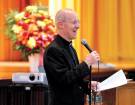


Cardinal Egan’s message about the parable of the Prodigal Son resonated with some 900 catechists and other religious educators at the annual archdiocesan Catechetical Forum, which carried the theme “The Gift of God’s Forgiveness.”
The cardinal shared a reflection based on The Return of the Prodigal Son as depicted in a work by the Italian Renaissance artist Guercino. In the painting, the father puts one arm around the back of his returned son as the younger man removes his torn, dirty shirt. With the other, he reaches for a new, clean shirt to offer his son.
“I understand confession as pulling off the old shirt and trusting that God has a nice, clean silk one there for you,” said Cardinal Egan, who is archbishop emeritus.
The cardinal recalled first telling the story to a class of inquirers who were learning about confession during his days as a young priest in his native Chicago. After the pastor baptized 76 new Catholics, one man the future cardinal taught wrote him a note about the feeling he experienced after his first confession.
“I took off my shirt for the first time and the Lord gave me a new one,” the cardinal said, quoting the letter.
His reflection came during his homily at the Mass opening the forum at Cardinal Spellman High School in the Bronx Oct. 18. Auxiliary Bishop Peter Byrne, episcopal vicar of Dutchess, Putnam and Northern Westchester counties, was the principal celebrant. Numerous priests serving in the archdiocese concelebrated.
Another daylong forum session was held at Sacred Heart parish in Monroe Oct. 4, with some 300 people attending.
The forum session in the Bronx featured keynote addresses in Spanish by Adrian Alberto Herrera, associate director of the Office of Evangelization and Catechesis in the Archdiocese of Galveston-Houston in Texas, and in English by Father James Martin, S.J., editor at large of America magazine and the best-selling author of numerous books, including the recently released “Jesus: A Pilgrimage.”
The forum is sponsored by the Archdiocesan Catechetical Office under the direction of Sister Joan Curtin, C.N.D.
Father Martin used humor to deliver an address that was entertaining and insightful.
One of Father Martin’s insights clearly illustrated his theory that it often takes time to fully understand Gospel stories. His education about the “Bay of Parables,” from Luke’s Gospel, where Jesus preached to crowds on the shore while standing in a boat on the Sea of Galilee, began in a Scripture class when he was a Jesuit novice 25 years ago.
“The idea you could identify exactly where one of Jesus’ Gospel passages happened really captivated me,” he said.
The next chapter of the story came years later when he was vacationing at a Jesuit summerhouse outside Boston. He and the other Jesuits could hear a commotion coming from the harbor, about a mile in the distance. The voices of teens sailing on the water sounded like they were two steps away.
When Father Martin remarked that the young people sounded as though they were very near, one of his Jesuit companions noted that sound travels easily over water and cited the story of Jesus preaching from the boat. “That’s why he did it that way,” he explained.
The final chapter came some years later when Father Martin was in the Holy Land for a two-week tour of Jerusalem and Galilee. When he inquired about the “Bay of Parables” to a pair of Scripture scholars he encountered, neither had ever heard of the place.
A little later on the trip, he finally found a Benedictine monk who not only had heard of the “Bay of Parables” but was able to direct Father Martin to the naturally occurring amphitheater.
He told his audience the journey there helped to cement a lesson—namely that the rocks, seeds, thorns and other everyday materials Jesus highlighted in his parables were found all around him in the Holy Land.
“Jesus used objects from nature to convey his message,” Father Martin said.
Another well-attended forum session, “The New Evangelization: The Role of the Catechist as Evangelizer,” was led by Father Arthur Mastrolia, pastor of St. Anthony’s parish in Yonkers.
Father Mastrolia reminded the catechists that St. John Paul II popularized the term New Evangelization in the run-up to the Jubilee Year of 2000, when the world feared the effect of Y2K on computer systems.
Pope John Paul II was neither anxious, nor afraid, as he sought to prepare the Church for the New Millennium, Father Mastrolia said. He wanted to live to see the Year 2000 and to lead the people of God into the new era.
In his encyclical, “The New Evangelization in the New Millennium,” the pope issued “a call to all Catholics to reconnect with and live more deeply the mystical traditions of the Church,” Father Mastrolia explained, adding that those traditions are not solely the province of mystics and saints but a state to which all Christians are called.
Boiling evangelization down to elementary terms, Father Mastrolia told the catechists before him that their job—and his—was to “make new friends for Christ.”
“Evangelization means nothing more than this,” he said, asking them to compare it to the excitement of introducing one of their friends to another friend.
The problem is that the world, and all its problems and challenges, can get in the way, Father Mastrolia said. Still, it remains the task of catechists of every generation “to bring others to fall in love with the one person who has brought sense and meaning to my life’s journey, the one who has answered my life’s questions.”